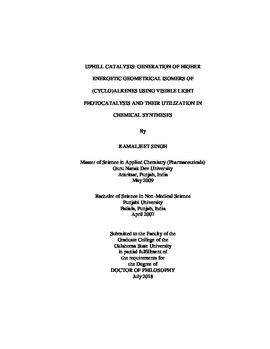| dc.contributor.advisor | Weaver, Jimmie D., III | |
| dc.contributor.author | Singh, Kamaljeet | |
| dc.date.accessioned | 2019-03-20T19:25:38Z | |
| dc.date.available | 2019-03-20T19:25:38Z | |
| dc.date.issued | 2018-07 | |
| dc.identifier.uri | https://hdl.handle.net/11244/317646 | |
| dc.description.abstract | We have performed a systematic study of utilizing excited state surfaces to promote endergonic reactions. As such, catalysis of potential endergonic reactions has not been considered since thermal catalysis cannot promote these reactions. However, this limitation can be overcome by utilizing excited state surfaces, from which all reaction directions are essentially exergonic. As a result, excitation can pump reactions in endergonic directions. In an approach to develop such reactions, we developed isomerization of trans-styrenoids to their higher energy geometrical cis-isomer using visible light and Ir(ppy)3 as a photocatalyst. This is a rare example of uphill catalysis which is endergonic by 2-7 kcal/mol of energy. We postulated that an energy transfer, from the photo-excited catalyst, was a key step in the operative mechanism. While synthetically useful, this only captured a small fraction of the potential energy of the excited state. In order to utilize a greater portion of the potential energy provided by the photocatalyst, we designed a series of trans-cycloalkenes. We envisioned that upon excitation, these cycloalkenes would undergo isomerization and, because of the small ring size, significant distortion from the ideal geometry, resulting in highly strained trans-cycloalkenes. The strain associated with the trans-cycloalkene raises its ground state energy and simultaneously activates it towards reactions with other functional groups. In contrast, the cis-cycloalkenes are completely unreactive in the absence of light and photocatalyst. Thus, we can use light as a stimulus to "turn on" the reactivity. We have utilized this general strategy to develop a novel bioconjugation strategy with azides, facilitate a rare thermal [2+2] cycloaddition with other alkenes, and facilitate an intramolecular hydroalkoxylation of an alkene to form complex, and previously inaccessible, oxabicycles. | |
| dc.format | application/pdf | |
| dc.language | en_US | |
| dc.rights | Copyright is held by the author who has granted the Oklahoma State University Library the non-exclusive right to share this material in its institutional repository. Contact Digital Library Services at lib-dls@okstate.edu or 405-744-9161 for the permission policy on the use, reproduction or distribution of this material. | |
| dc.title | Uphill catalysis: Generation of higher energetic geometrical isomers of (cyclo)alkenes using visible light photocatalysis and their utilization in chemical syntheses | |
| dc.contributor.committeeMember | Bunce, Richard A. | |
| dc.contributor.committeeMember | Rahaim, Ronald J. | |
| dc.contributor.committeeMember | Fennell, Christopher J. | |
| dc.contributor.committeeMember | Deng, Junpeng | |
| osu.filename | Singh_okstate_0664D_15824.pdf | |
| osu.accesstype | Open Access | |
| dc.type.genre | Dissertation | |
| dc.type.material | Text | |
| thesis.degree.discipline | Chemistry | |
| thesis.degree.grantor | Oklahoma State University | |
